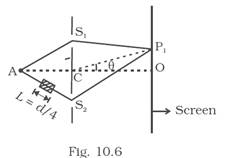A small transparent slab containing material of μ =1.5 is placed along AS2 (Fig.10.6). What will be the distance from O of the principal maxima and of the first minima on either side of the principal maxima obtained in the absence of the glass slab.

AC = CO = D, S1C = S2C = d << D
Whenever a transparent slab of refractive index μ and thickness t is inserted in the path of the ray the fringes on the screen shifts by (μ-1) t towards the slab.
Given AC = CO = D, S1C = S2C = d << D
L=d/4, μ=1.5
∴ the optical path difference is given by
![]()
For principal maxima OPD=0, i.e.
![]()
![]()
![]()
The distance from O to principal maxima is,
![]()
The path difference for first minima is ± (λ/2)
i.e.
![]()

Since diffraction occurs when slit width is equals to the wavelength i.e. λ =d


Considering the positive side,

Considering the negative side,

The distance of first principal minima from O on the positive side is,

The distance of first principal minima from O on the negative side is,
![]()